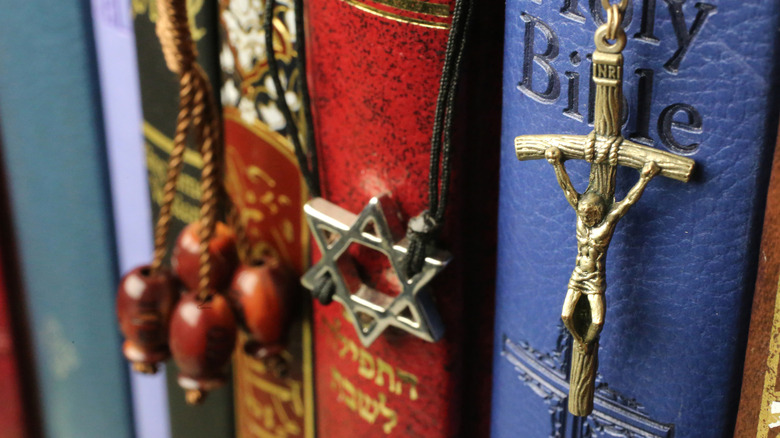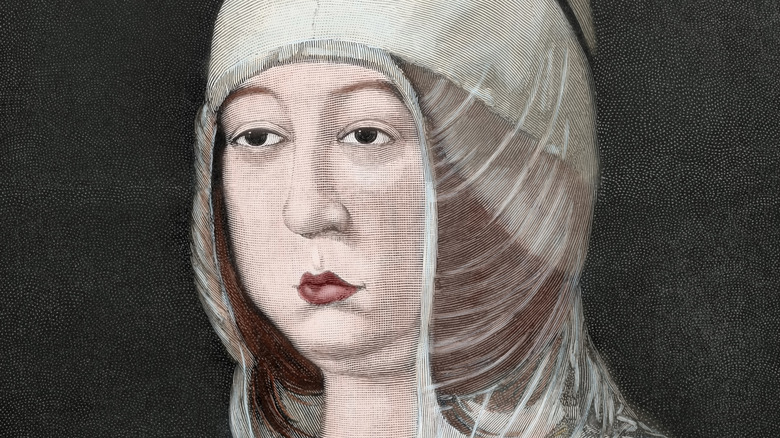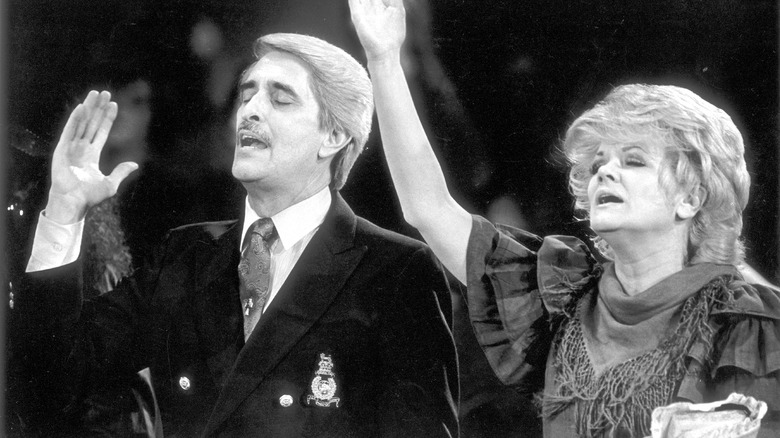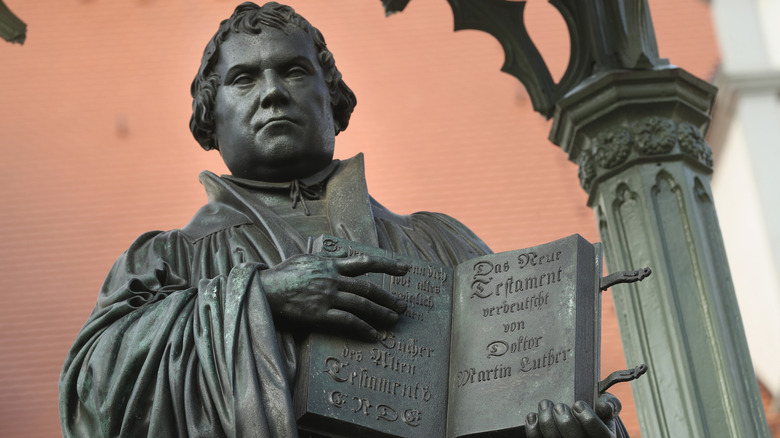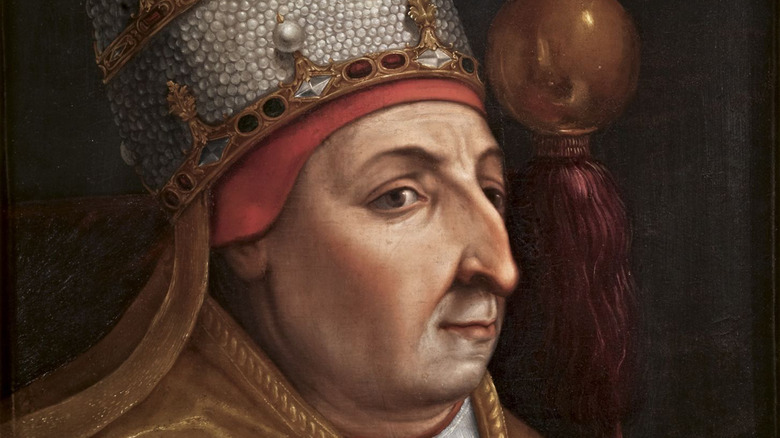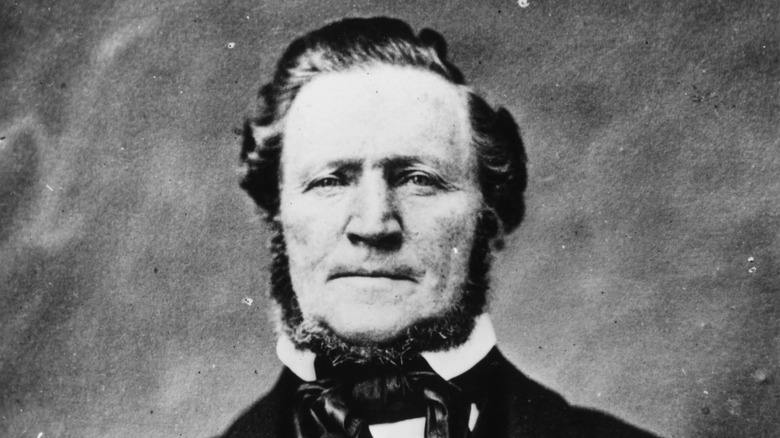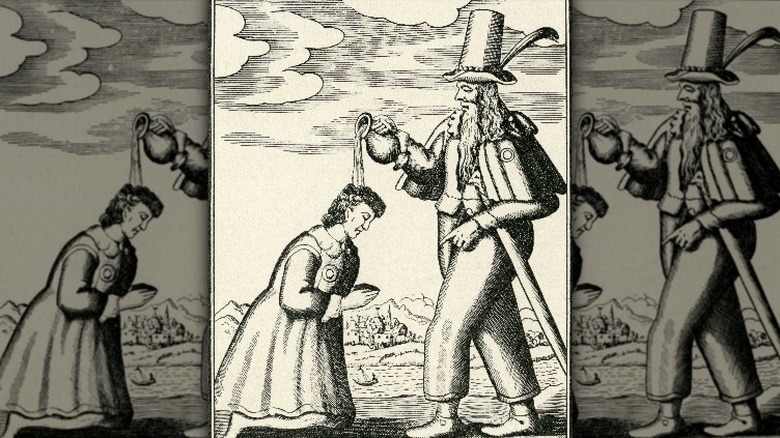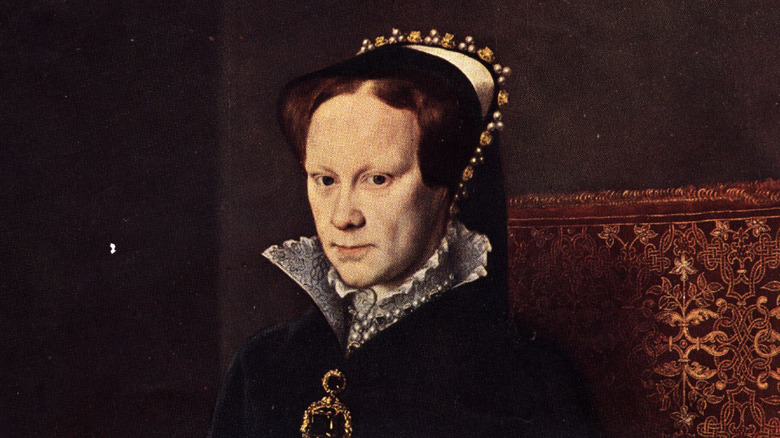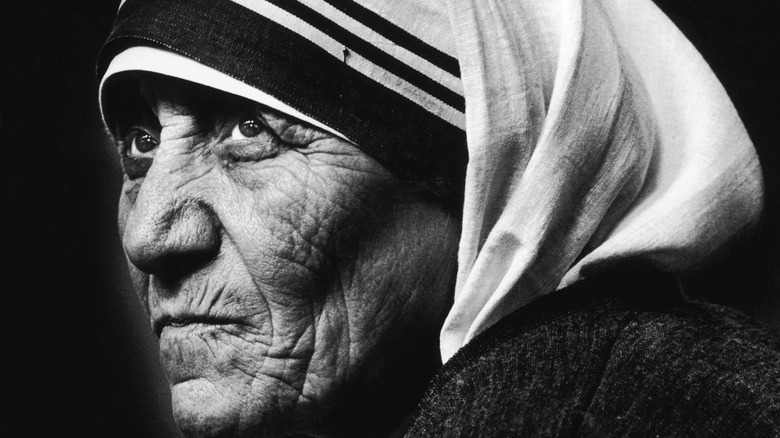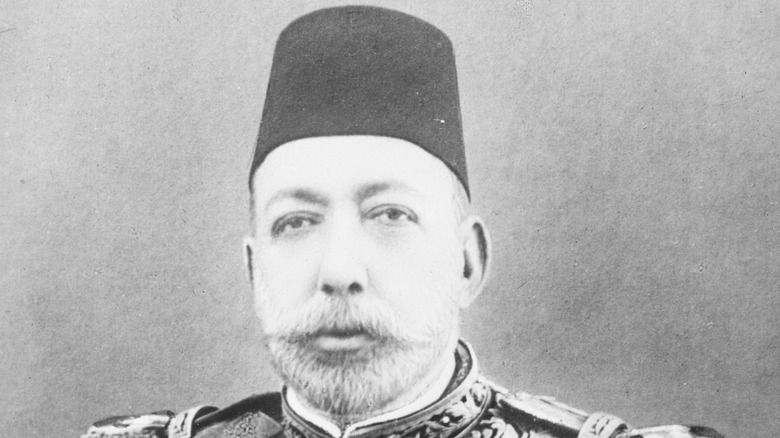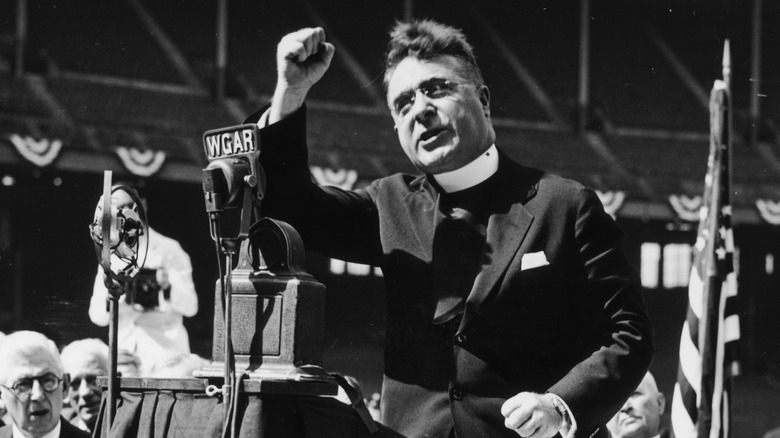Respected Religious Figures Who Were Actually Terrible People
Not unreasonably, people often look to religious leaders for examples of how best to live ethical lives. And while some religious leaders do in fact lead by example, following the precepts of their faith in matters great and small, others... don't. Some of history's most unsavory actors have been those who acted by, for, and within their religions (or at least claimed to). Monarchs, popes, nuns, and even false messiahs have led their flocks astray, killed uncountable numbers, and helped themselves to the donations of the faithful.
Some of these leaders were exposed during their lifetimes, while others' legacies were only dismantled after their deaths. Whether they face any judgment beyond is unknowable, but we can hope: Luke 17:2 promises that "It is better for him if a millstone is hung around his neck and he is thrown into the sea, than that he may cause one of these little ones to sin." Read on for 11 notable necks that well deserve millstones by modern standards.
Isabella I of Castile
As royal resumes go, Isabella of Castile has one of the grandest, especially as a woman in the man's world of 15th-century Iberia. She won the throne of Castile in a civil war and married her Aragonese peer to create the more-or-less united Spain familiar today. In the busy year of 1492 alone, she smashed Granada, the last Muslim state in the Iberian Peninsula; sent Christopher Columbus west to find ... India; and expelled all the Jews from her territories. For all these actions spreading her Catholic faith, she and husband Ferdinand of Aragon were dubbed the "Catholic Monarchs" by Pope Alexander VI.
With Granada absorbed and European antisemitism always high, Isabella enacted the Alhambra Decree, which gave the Jews of Spain (and Ferdinand's spare territories in southern Italy) less than four months to convert or to sell up and depart forever, on pain of death. Her justification was that the Jews were leading her good, Christian subjects astray in religious matters. Scattering largely into the Ottoman Empire, Italy, and Portugal , these exiled Spanish Jews were the ancestors of the modern Sephardic communities.
To Isabella's limited credit, she disapproved of enslaving the native people in the New World (preferring them to be forced into a system similar to European serfdom), but nor did she put much effort as queen into preventing it. Her well-documented ethnic cleansing and willingness to condone horrors in the conquest of the Americas made her one of history's most dangerous queens, but it hasn't destroyed her modern reputation: She remains a candidate for sainthood in the Catholic Church, though the process has not advanced since the early 1990s.
Jan Crouch
From today, it's easy to look back on the television evangelism boom of the 1970s and 1980s with bemusement and contempt: Who were these televangelists who were anything but holy, and who took them seriously? But putting God on TV was big business back then, and one of its foremost female faces was Jan Crouch. In 1973, the misty-eyed, mighty-wigged Crouch founded, with husband Paul, the Trinity Broadcasting Network, which became one of the heavy hitters in the televangelism game. The Crouches spread into other interests as well, producing a wide variety of content for their sprawling connection of networks and purchasing the Holy Land Experience theme park.
Late in Crouch's life, her Christ-following act was exposed as a sham. She was accused of affairs and financial improprieties, including that she had used funds from the network (a registered nonprofit) for personal expenses, among them a motor home for her dogs. Most appalling, shortly after her 2016 death, a court found her estate financially liable for the trauma suffered by one of her granddaughters after her rape by a station employee. The granddaughter, then 13 years old, had reported the assault to Crouch, who flew into a rage, blamed the victim, and worked to cover up the crime. Crouch was found 45% liable for the resulting trauma, sharing blame with the assailant and the victim's mother. If there is a judgment after death, Crouch may find herself wishing she'd sprung for asbestos-lined wigs.
Martin Luther
In many ways, Martin Luther is the most human of the Protestant reformers. In a gallery of sour-faced men talking hell this, hell that, Luther comes across as almost... fun. He drank a lot, even by the beery standards of early modern Germany, and who among us can honestly say we haven't fantasized about nailing an itemized list of complaints to the front door of our workplace? He also married a runaway nun, responded to his excommunication by announcing that whoever had written the bull of excommunication was the Antichrist, and referred to Pope Paul III as "fartz esel," which translates to "fart ass."
Alas, even in a notoriously antisemitic period, Martin Luther's hatred of Jews was extreme. Over the course of his career as a reformist preacher, he moved from what was then fairly standard antisemitism to truly vile and ferocious attacks, advocating in his 1543 work "On the Jews and Their Lies" that Jewish homes and synagogues be destroyed, the open practice of Judaism prohibited, and Jews expelled from Germany if they refused to convert. If this sounds familiar, it should: Luther's diatribes have never fallen out of favor among anti-Jewish bigots, and both Nazis and their modern "intellectual" descendants have made eager reference to Luther's late works. Editions with antisemitic cover imagery remain available today.
Pope Nicholas V
For most modern people, one of the real baseline positions for being a "good person" is opposing slavery. After centuries of war and countless wasted and blighted lives, we have finally arrived at a consensus: You can't just have people. One of the principal figures who made this specification necessary was the late medieval pope Nicholas V, who asked himself what Jesus would do and arrived at the incomprehensible answer, "Instruct the king of Portugal to enslave sub-Saharan Africans."
The context here is the Age of Discovery, during which European navigators began exploring beyond the edges of the continent. In the generations before the Spanish invasion of the Americas, mariners were finding various Atlantic islands and poking around the African coast. There was a certain existing etiquette of who was and was not eligible to be enslaved in medieval Europe, but when Portuguese sailors kidnapped some Berbers off the West African coast, a ruling on this situation was required. It wasn't good: Nicholas V's 1455 bull instructed the king of Portugal to "invade, search out, capture, vanquish, and subdue all Saracens and pagans whatsoever... and to reduce their persons to perpetual slavery." People would be captured or bought in Africa in their millions, and they and their descendants would suffer in bondage until Brazil abolished slavery in 1889, the last country in the Americas to do so. Nicholas V's successor, Leo XIII, sent a Golden Rose, a papal gift indicating great favor, to Isabel, the Brazilian princess who signed the emancipation law.
Brigham Young
The Latter-Day Saint or Mormon movement has drawn a lot of mockery in contemporary American culture, which can obscure the tragic history of Mormonism and the very real challenges early Mormons went through to practice their faith. Facing expulsion from Illinois, the Mormons trudged west during 1846 and 1847 into what became Utah, establishing themselves in Mexican territory that would soon become American. Unfortunately, they did so under the guidance of Brigham Young.
During his stewardship of the Latter-Day Saints, Young codified restrictions against Black people fully participating in the Mormon church that lasted until 1978; Black congregants could enter the church but not hold important leadership positions. Less well known is his potential culpability in the Mountain Meadows Massacre, the slaughter of a lightly armed wagon train of pioneer families bound for California, during a period of tension with the federal government. Assisted by Paiute allies, Mormon extremists shot a child among the settlers before besieging them, offering terms of surrender, and then killing everyone over 7 years old. The extent to which Mormon leadership knew of this plan in advance is unclear, but the church, with Young at its head, blamed the Paiute alone, a denial that was only acknowledged in 2007.
Shabbetai Tzevi
If you're going to announce that you're the long-awaited Messiah, you have to be sure. In the ferociously antisemitic Europe of the 17th century, many Jews pinned their hopes on God's sending a savior to their aid. What they got was Shabbetai Tzevi, who talked big until the going got tough — and then folded like a cheap tallit.
Born in the Ottoman Empire, Tzevi studied the Kabbalah as a young man and at 22, an age when most Americans are still naming their bongs, he proclaimed himself the Messiah. He ping-ponged around the empire, attracting followers and detractors in Cairo, Gaza, Jerusalem, and other cities. Jewish communities in other cities in Europe saw some of their members convinced by reports of this "Messiah," and in extreme cases people abandoned their worldly goods and families and headed to Turkey to find him.
Who did find him were agents of Sultan Mehmed IV, tired of his rabble-rousing. The sultan had Tzevi imprisoned in Adrianople and threatened with torture unless he converted to Islam, which he eagerly accepted. A handful of his followers joined him in the religion, but most trudged back to unhappy lives, having wagered it all on the "Messiah" and lost.
Mary I of England
We all know the story: Henry VIII, hot for Anne Boleyn, pulled England out of the Catholic church to divorce his sonless wife Catherine of Aragon. But not everyone remembers the ironic outcome that, several wives and the death of one son later, Mary, Henry's daughter by Catherine, became the first woman to truly rule England. (Others had tried, but Mary made it stick.)
Unfortunately, Mary was her mother's daughter — and through that relationship, the granddaughter of the ferocious female crusader Isabella of Castile. Grateful to God for placing her on her father's throne, Mary saw her duty as restoring England to the bosom of the Roman church by any means necessary. Twenty-plus years of anti-Catholic propaganda and the prosperity resulting from redistribution of church property made this re-Romanizing a bit of a challenge, but Mary had a not-so-secret weapon: a willingness to set people on fire. Over the five-ish years of Mary's reign, nearly 300 people, mostly everyday "commoners," were sent to the stake for resisting the latest round of religious whiplash. Mary was so vehement about sending people to the stake she made her lieutenant, the Bishop of London, whine that he didn't like that people called him "Bloody Bonner."
Mary's marriage to the king of Spain was childless, and so in a further Tudor succession irony, her death in 1558 left the throne to her Protestant half-sister, Elizabeth, who is remembered more fondly in part because she simply had people's heads cut off.
Mother Teresa
For people who remember her heyday, Mother Teresa is a model of holiness, a figure of self-denial whose work with the desperately poor and sick in Calcutta slums was admirable almost beyond belief. It's a white savior narrative, if complicated slightly by Mother Teresa's origin in poor Albania, run for much of her life by a ruthless dictator you probably haven't heard of: Enver Hoxha.
In recent years, Teresa's legacy has become more complex. Atheist gadfly Christopher Hitchens wrote an entire book, "The Missionary Position," attacking the nun's work, arguing that she and her workers performed baptisms on sick, dying, and potentially unaware patients. (This accusation is further complicated by its usage by Hindu nationalists within India.) While the mere fact of a deathbed baptism wouldn't raise many eyebrows, the recipients may not have been in a position to give informed consent.
Additionally, various writers (including a former editor of the British medical journal The Lancet) have accused Mother Teresa's Sisters of Charity of providing poor care, with doctors seldom available and few of the sisters having any formal medical training. This resulted in needless suffering and death — and was avoidable with prudent use of the millions of dollars the organization received once it became a cause célèbre. Hitchens and others accused Teresa of fetishizing poverty and suffering as Christlike, exemplified in her statement to the victims of a catastrophic industrial disaster in the city of Bhopal: Rather than offering to help hold the business interests responsible, she merely exhorted the injured and bereaved to forgive.
Mehmed V of the Ottoman Empire
One of the first genocides of the 20th century was the ethnic cleansing of Armenians from much of the Ottoman Empire. Though it is explicitly denied by law in modern Turkey, scholars agree that the faltering state, an ally of the doomed Central Powers during World War I, concentrated, displaced, and slaughtered something like 75% of its prewar Armenian population of about 2 million. The Ottoman Empire had done badly in the Balkan Wars of the early 20th century, losing land and prestige. Armenians, who were mostly Christian and spoke their own language, were blamed as saboteurs.
By 1914, the sultan of the Ottoman Empire had lost most of his power to a secular government, and Mehmed V did not have the authority to plan, direct, or enact the destruction of his empire's Armenians. What he did have was a potential pulpit from which to denounce it: In his role as sultan he was also caliph, a religious office implying the holder is the heir of Mohammed and therefore an eminent spiritual (and political) authority among Muslims. Mehmed was content to use this spiritual office to declare World War I a holy war but not to protest against a program of rape, murder, and displacement spreading across the lands he theoretically ruled. He even ignored a letter from the contemporary pope exhorting him to do... something. The office of caliph, abolished by the Turkish republic in 1924, has lain dormant for a century.
Jim Bakker
Televangelist Jim Bakker built a cash-for-prayers enterprise that was one of the most successful, in dollar terms, of the American televangelism wave. (Among some audiences, he's better known for being the husband of eyeshadow aficionado Tammy Faye.) The Bakkers and their associates lived big on money from their ministry-slash-business, PTL Enterprises, but it all came crashing down in 1987, when the organization's books were shown to have cratering deficits, the IRS came knocking, and Bakker was accused of a series of interlocking sex scandals. Among the allegations were that Bakker had raped an employee, bought her silence with misappropriated funds, and engaged in consensual sex with a male employee.
You might think convictions for fraud, accusations of rape, and disgrace in front of a captivated American public would have chastened him, but you'd be assuming he was capable of feeling shame. Bakker popped back into the news during the COVID-19 pandemic, in legal trouble again for selling colloidal silver as a coronavirus treatment. He remains active in a new church and with a new show; the second item available for "purchase" in his show's online store is a donation of $1,000.
Father Charles Coughlin
In the years before WWII, one of the most prominent pro-fascist voices in the United States was "radio priest" Father Charles Coughlin. A voluble antisemite and Hitler fanboy, Coughlin spent most of the 1930s spewing hatred over American airways to his audience that, at its peak, reached over 90 million people.
Ironically, Coughlin first made it onto the radio after the Ku Klux Klan burned a cross on the lawn of his church; he hoped to use the platform to explain Catholicism to the public. His political stances started off as general, if fervent, anti-communism (always popular in the USA) and support for Franklin Roosevelt, but by 1936 he was ready to run a third-party candidate for president. His pet, North Dakota congressman William Lemke, did poorly in the election; deprived of this avenue for political power, Coughlin doubled down on his antisemitic howlings. He reprinted the anti-Jewish forgery "The Protocols of the Elders of Zion" in his magazine, Social Justice, and encouraged attacks on Jewish Americans, their homes, and their businesses. His flunkies' vandalism included defacing Jewish-owned properties with the swastika recently embraced in Germany. After the United States entered World War II, both the government and the church leaned on Coughlin to pipe down, with his magazine charged with giving aid and comfort to the enemy. He returned to his parish duties and died peacefully and unrepentant in 1979.
If you or anyone you know has been a victim of sexual assault, help is available. Visit the Rape, Abuse & Incest National Network website or contact RAINN's National Helpline at 1-800-656-HOPE (4673).
